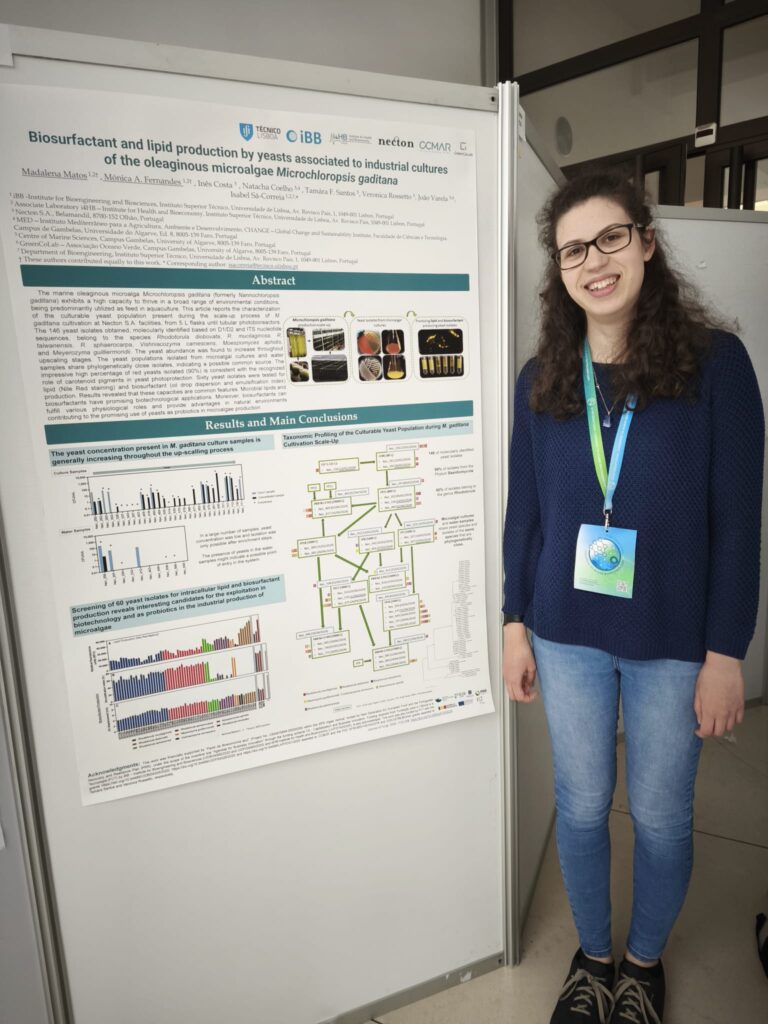Your cart is currently empty!
Poster presentation in the 1st International Congress on Algae Biotechnology – Madalena Matos
—

Title
Biosurfactant and lipid production by yeasts associated to industrial cultures of the oleaginous microalgae Microchloropsis gaditana
Authors
Madalena Matos, Mónica A. Fernandes, Inês Costa, Natacha Coelho, Tamára F. Santos, Veronica Rossetto, João Varela, Isabel Sá-Correia
Abstract
The marine oleaginous microalga Microchloropsis gaditana (formerly Nannochloropsis gaditana) exhibits rapid growth and high capacity to thrive in a broad range of environmental conditions and is predominantly utilized as feed in aquaculture. The mechanisms of algae-microbial interactions are poorly understood, having the potential to result in a decrease of biomass production and other products of interest and, in the worst cases, lead to the collapse of the microalgal culture. In the case of positive symbiotic interactions, these can promote algal growth, the synthesis of added value bioproducts, and offer advantages in downstream processing, thus contributing to the reduction of production costs. As a way to further understand these interactions, in particular microalgae-yeast interactions, we characterized the culturable yeast population present during a three-month industrial scale-up cultivation of M. gaditana cultivation at Necton S.A. facilities, from 5-L flasks until tubular photobioreactors (max. 27000 L). The 146 yeast isolates obtained were molecularly identified, based on D1/D2 and ITS rDNA regions. Ninety-nine percent of the isolates belong to six species of the phylum Basidiomycota, including four Rhodotorula species (R. diobovata, R. mucilaginosa, R. taiwanensis and R. sphaerocarpa), Vishniacozyma carnescens and Moesziomyces aphidis. In the phylum Ascomycota, only Meyerozyma guilliermondii was identified. The abundance of microalgae culture-associated yeast isolates increased throughout upscaling stages. The yeast populations isolated from microalgal cultures and water samples share yeast species of phylogenetically close isolates indicating a possible common source. The impressively high percentage of red yeasts isolated (90%) is consistent with the recognized role of carotenoid pigments in yeast photoprotection. The screening of 60 yeast isolates for lipid and biosurfactant production revealed that these capacities are common features among the isolated species. Besides the biotechnological potential of microbial oils and biosurfactants, biosurfactants can also fulfill various physiological roles and provide advantages in natural environments. Such roles include antimicrobial activity, the capacity to regulate microbial attachment/detachment to the surfaces and to increase the bioavailability of hydrophobic nutrients promoting their uptake. These reported roles can contribute, in many ways, to the promising use of yeasts as probiotics in industrial microalgae production.
